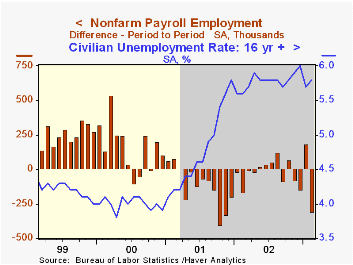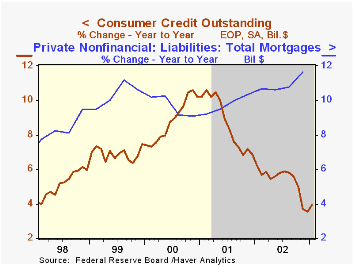 Global| Mar 07 2003
Global| Mar 07 2003Nonfarm Payrolls Plunge
by:Tom Moeller
|in:Economy in Brief
Summary
Nonfarm payrolls fell by the most for any month since November 2001. Consensus expectations were for a 10,000 worker rise. The rise in January payrolls was revised up moderately. February payrolls may have been depressed by the [...]

Nonfarm payrolls fell by the most for any month since November 2001. Consensus expectations were for a 10,000 worker rise. The rise in January payrolls was revised up moderately.
February payrolls may have been depressed by the activation of civilian workers for military duty.
Diffusion indexes for nonfarm payrolls reversed all the improvement of the month prior. The one-month index fell to 41.1, the lowest level since November 2001. The three month diffusion index also slumped to 40.3. By measuring the breadth of gain, these indexes are leading indicators of job growth.
The unemployment rate rose to an expected 5.8%. Employment fell 128,000 (-0.1% m/m, +0.7% y/y) following a sharp rise in January. The labor force rose 19,000 (0.0% m/m, +0.9% y/y).
Amongst industries the number of factory sector jobs fell 53,000 (-0.3% m/m, -2.9% y/y), about the average rate of decline last year. The one-month diffusion index for the factory sector cratered to 39.0, the lowest level in a year. Construction jobs fell 48,000 (-1.1% y/y). Jobs in service producing industries fell 204,000 (0.4% y/y). Retail hiring fell 92,000 (-0.7% y/y). Services fell 86,000 and government employment rose 13,000.
The index of aggregate hours worked (employment times hours worked) fell 1.0%, the fourth decline in five months. The average of this index so far in 1Q is 0.1% below 4Q02.
Over the last ten years there has been a 53% correlation between the quarterly change in aggregate hours worked and real GDP. That correlation is down from 89% in the 1980s. The decline is due to the recent acceleration in productivity growth.
Average hourly earnings were unexpectedly strong. Strength was in several service industries.
The nonfarm payroll employment figures are based on reports provided to the US Labor Department by businesses, while the figures from which the unemployment rate is derived are based on a survey of US households.
| Employment | Feb | Jan | Y/Y | 2002 | 2001 | 2000 |
|---|---|---|---|---|---|---|
| Payroll Employment | -308,000 | 185,000 | -0.1% | -0.9% | 0.2% | 2.2% |
| Manufacturing | -53,000 | -4,000 | -2.9% | -5.5% | -4.2% | -0.4% |
| Average Weekly Hours | 34.1 | 34.3 | 34.2 | 34.2 | 34.2 | 34.4 |
| Average Hourly Earnings | 0.7% | -0.1% | 3.2% | 3.2% | 4.0% | 3.8% |
| Unemployment Rate | 5.8% | 5.7% | 5.6% | 5.8% | 4.8% | 4.0% |
by Tom Moeller March 7, 2003

Consumer credit outstanding (which excludes mortgages) surged 0.8% in January, the most for any one month since November 2001. Consensus expectations had been for a $1.0B decline. The preliminary report of a $4.0 decline in December was revised to positive due to raised figures for both revolving and nonrevolving credit.
Revolving credit rose 0.6%, the most in any month since November 2001. The rise follows four consecutive months of decline.
Nonrevolving credit surged 0.8% following a 0.6% December gain revised from 0.4%.
Research by the US Federal Reserve providing an overview of consumer data and credit reporting can be found here.
Comments made in Paris, France by Chairman Alan Greenspan at the International Symposium on Monetary Policy, Economic Cycle, and Financial Dynamics can be found here.
| Consumer Credit Outstanding | Jan m/m | Dec m/m | Y/Y | 2002 | 2001 | 2000 |
|---|---|---|---|---|---|---|
| Total | $13.2B | $2.0B | 4.0% | 3.5% | 6.8% | 10.2% |
| Revolving | $4.5B | $-3.9B | 2.3% | 1.6% | 5.0% | 11.7% |
| Nonrevolving | $8.6B | $5.9B | 5.1% | 4.9% | 8.2% | 9.1% |
Tom Moeller
AuthorMore in Author Profile »Prior to joining Haver Analytics in 2000, Mr. Moeller worked as the Economist at Chancellor Capital Management from 1985 to 1999. There, he developed comprehensive economic forecasts and interpreted economic data for equity and fixed income portfolio managers. Also at Chancellor, Mr. Moeller worked as an equity analyst and was responsible for researching and rating companies in the economically sensitive automobile and housing industries for investment in Chancellor’s equity portfolio. Prior to joining Chancellor, Mr. Moeller was an Economist at Citibank from 1979 to 1984. He also analyzed pricing behavior in the metals industry for the Council on Wage and Price Stability in Washington, D.C. In 1999, Mr. Moeller received the award for most accurate forecast from the Forecasters' Club of New York. From 1990 to 1992 he was President of the New York Association for Business Economists. Mr. Moeller earned an M.B.A. in Finance from Fordham University, where he graduated in 1987. He holds a Bachelor of Arts in Economics from George Washington University.






